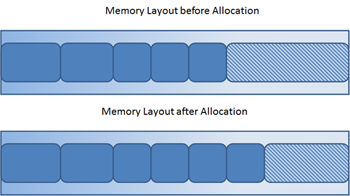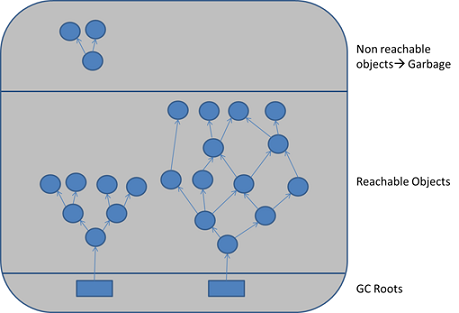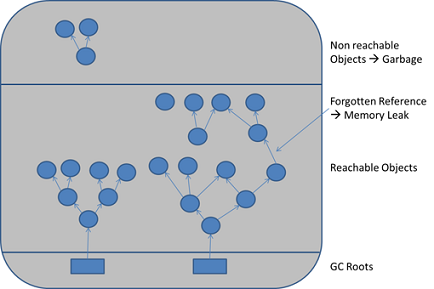How Garbage Collection Really Works
Java Memory Management, with its built-in garbage collection, is one of the language's finest achievements. It allows developers to create new objects without worrying explicitly about memory allocation and deallocation, because the garbage collector automatically reclaims memory for reuse. This enables faster development with less boilerplate code, while eliminating memory leaks and other memory-related problems. At least in theory.
Ironically, Java garbage collection seems to work too well, creating and removing too many objects. Most memory-management issues are solved, but often at the cost of creating serious performance problems. Making garbage collection adaptable to all kinds of situations has led to a complex and hard-to-optimize system. In order to wrap your head around garbage collection, you need first to understand how memory management works in a Java Virtual Machine (JVM).
How Garbage Collection Really Works
Many people think garbage collection collects and discards dead objects. In reality, Java garbage collection is doing the opposite! Live objects are tracked and everything else designated garbage. As you'll see, this fundamental misunderstanding can lead to many performance problems.
Let's start with the heap, which is the area of memory used for dynamic allocation. In most configurations the operating system allocates the heap in advance to be managed by the JVM while the program is running. This has a couple of important ramifications:
- Object creation is faster because global synchronization with the operating system is not needed for every single object. An allocation simply claims some portion of a memory array and moves the offset pointer forward (see Figure 2.1). The next allocation starts at this offset and claims the next portion of the array.
- When an object is no longer used, the garbage collector reclaims the underlying memory and reuses it for future object allocation. This means there is no explicit deletion and no memory is given back to the operating system.
 Figure 2.1: New objects are simply allocated at the end of the used heap.
Figure 2.1: New objects are simply allocated at the end of the used heap.
All objects are allocated on the heap area managed by the JVM. Every item that the developer uses is treated this way, including class objects, static variables, and even the code itself. As long as an object is being referenced, the JVM considers it alive. Once an object is no longer referenced and therefore is not reachable by the application code, the garbage collector removes it and reclaims the unused memory. As simple as this sounds, it raises a question: what is the first reference in the tree?
Garbage-Collection Roots — The Source of All Object Trees
Every object tree must have one or more root objects. As long as the application can reach those roots, the whole tree is reachable. But when are those root objects considered reachable? Special objects called garbage-collection roots (GC roots; see Figure 2.2) are always reachable and so is any object that has a garbage-collection root at its own root.
There are four kinds of GC roots in Java:
- Local variables are kept alive by the stack of a thread. This is not a real object virtual reference and thus is not visible. For all intents and purposes, local variables are GC roots.
- Active Java threads are always considered live objects and are therefore GC roots. This is especially important for thread local variables.
- Static variables are referenced by their classes. This fact makes them de facto GC roots. Classes themselves can be garbage-collected, which would remove all referenced static variables. This is of special importance when we use application servers, OSGi containers or class loaders in general. We will discuss the related problems in the Problem Patterns section.
- JNI References are Java objects that the native code has created as part of a JNI call. Objects thus created are treated specially because the JVM does not know if it is being referenced by the native code or not. Such objects represent a very special form of GC root, which we will examine in more detail in the Problem Patterns section below.
 Figure 2.2: GC roots are objects that are themselves referenced by the JVM and thus keep every other object from being garbage-collected.
Figure 2.2: GC roots are objects that are themselves referenced by the JVM and thus keep every other object from being garbage-collected.
Therefore, a simple Java application has the following GC roots:
- Local variables in the main method
- The main thread
- Static variables of the main class
Marking and Sweeping Away Garbage
To determine which objects are no longer in use, the JVM intermittently runs what is very aptly called a mark-and-sweep algorithm . As you might intuit, it's a straightforward, two-step process:
- The algorithm traverses all object references, starting with the GC roots, and marks every object found as alive.
- All of the heap memory that is not occupied by marked objects is reclaimed. It is simply marked as free, essentially swept free of unused objects.
Garbage collection is intended to remove the cause for classic memory leaks: unreachable-but-not-deleted objects in memory. However, this works only for memory leaks in the original sense. It's possible to have unused objects that are still reachable by an application because the developer simply forgot to dereference them. Such objects cannot be garbage-collected. Even worse, such a logical memory leak cannot be detected by any software (see Figure 2.3). Even the best analysis software can only highlight suspicious objects. We will examine memory leak analysis in the Analyzing the Performance Impact of Memory Utilization and Garbage Collection section, below.
 Figure 2.3: When objects are no longer referenced directly or indirectly by a GC root, they will be removed. There are no classic memory leaks. Analysis cannot really identify memory leaks; it can only point out suspicious objects.
Figure 2.3: When objects are no longer referenced directly or indirectly by a GC root, they will be removed. There are no classic memory leaks. Analysis cannot really identify memory leaks; it can only point out suspicious objects.Java Memory Management, with its built-in garbage collection, is one of the language's finest achievements. It allows developers to create new objects without worrying explicitly about memory allocation and deallocation, because the garbage collector automatically reclaims memory for reuse. This enables faster development with less boilerplate code, while eliminating memory leaks and other memory-related problems. At least in theory.
Ironically, Java garbage collection seems to work too well, creating and removing too many objects. Most memory-management issues are solved, but often at the cost of creating serious performance problems. Making garbage collection adaptable to all kinds of situations has led to a complex and hard-to-optimize system. In order to wrap your head around garbage collection, you need first to understand how memory management works in a Java Virtual Machine (JVM).
How Garbage Collection Really Works
Many people think garbage collection collects and discards dead objects. In reality, Java garbage collection is doing the opposite! Live objects are tracked and everything else designated garbage. As you'll see, this fundamental misunderstanding can lead to many performance problems.
Let's start with the heap, which is the area of memory used for dynamic allocation. In most configurations the operating system allocates the heap in advance to be managed by the JVM while the program is running. This has a couple of important ramifications:
- Object creation is faster because global synchronization with the operating system is not needed for every single object. An allocation simply claims some portion of a memory array and moves the offset pointer forward (see Figure 2.1). The next allocation starts at this offset and claims the next portion of the array.
- When an object is no longer used, the garbage collector reclaims the underlying memory and reuses it for future object allocation. This means there is no explicit deletion and no memory is given back to the operating system.
 Figure 2.1: New objects are simply allocated at the end of the used heap.
Figure 2.1: New objects are simply allocated at the end of the used heap.
All objects are allocated on the heap area managed by the JVM. Every item that the developer uses is treated this way, including class objects, static variables, and even the code itself. As long as an object is being referenced, the JVM considers it alive. Once an object is no longer referenced and therefore is not reachable by the application code, the garbage collector removes it and reclaims the unused memory. As simple as this sounds, it raises a question: what is the first reference in the tree?
Garbage-Collection Roots — The Source of All Object Trees
Every object tree must have one or more root objects. As long as the application can reach those roots, the whole tree is reachable. But when are those root objects considered reachable? Special objects called garbage-collection roots (GC roots; see Figure 2.2) are always reachable and so is any object that has a garbage-collection root at its own root.
There are four kinds of GC roots in Java:
- Local variables are kept alive by the stack of a thread. This is not a real object virtual reference and thus is not visible. For all intents and purposes, local variables are GC roots.
- Active Java threads are always considered live objects and are therefore GC roots. This is especially important for thread local variables.
- Static variables are referenced by their classes. This fact makes them de facto GC roots. Classes themselves can be garbage-collected, which would remove all referenced static variables. This is of special importance when we use application servers, OSGi containers or class loaders in general. We will discuss the related problems in the Problem Patterns section.
- JNI References are Java objects that the native code has created as part of a JNI call. Objects thus created are treated specially because the JVM does not know if it is being referenced by the native code or not. Such objects represent a very special form of GC root, which we will examine in more detail in the Problem Patterns section below.
 Figure 2.2: GC roots are objects that are themselves referenced by the JVM and thus keep every other object from being garbage-collected.
Figure 2.2: GC roots are objects that are themselves referenced by the JVM and thus keep every other object from being garbage-collected.
Therefore, a simple Java application has the following GC roots:
- Local variables in the main method
- The main thread
- Static variables of the main class
Marking and Sweeping Away Garbage
To determine which objects are no longer in use, the JVM intermittently runs what is very aptly called a mark-and-sweep algorithm . As you might intuit, it's a straightforward, two-step process:
- The algorithm traverses all object references, starting with the GC roots, and marks every object found as alive.
- All of the heap memory that is not occupied by marked objects is reclaimed. It is simply marked as free, essentially swept free of unused objects.
Garbage collection is intended to remove the cause for classic memory leaks: unreachable-but-not-deleted objects in memory. However, this works only for memory leaks in the original sense. It's possible to have unused objects that are still reachable by an application because the developer simply forgot to dereference them. Such objects cannot be garbage-collected. Even worse, such a logical memory leak cannot be detected by any software (see Figure 2.3). Even the best analysis software can only highlight suspicious objects. We will examine memory leak analysis in the Analyzing the Performance Impact of Memory Utilization and Garbage Collection section, below.
 Figure 2.3: When objects are no longer referenced directly or indirectly by a GC root, they will be removed. There are no classic memory leaks. Analysis cannot really identify memory leaks; it can only point out suspicious objects.
Figure 2.3: When objects are no longer referenced directly or indirectly by a GC root, they will be removed. There are no classic memory leaks. Analysis cannot really identify memory leaks; it can only point out suspicious objects.How Garbage Collection Really Works的更多相关文章
- Java Garbage Collection Basics--转载
原文地址:http://www.oracle.com/webfolder/technetwork/tutorials/obe/java/gc01/index.html Overview Purpose ...
- AutoReleasePool 和 ARC 以及Garbage Collection
AutoReleasePool autoreleasepool并不是总是被auto 创建,然后自动维护应用创建的对象. 自动创建的情况如下: 1. 使用NSThread的detachNewThread ...
- 2.5 – Garbage Collection 自动垃圾回收 Stop-the-world vs. incremental vs. concurrent 垃圾回收策略
2.5 – Garbage Collection 自动垃圾回收 Lua 5.3 Reference Manual http://www.lua.org/manual/5.3/manual.html# ...
- Garbage Collection Optimization for High-Throughput and Low-Latency Java Applications--转载
原文地址:https://engineering.linkedin.com/garbage-collection/garbage-collection-optimization-high-throug ...
- Why you need to understand garbage collection
Why you need to understand garbage collection I’ve been interviewing lots of C# developers recently, ...
- Unity性能优化(3)-官方教程Optimizing garbage collection in Unity games翻译
本文是Unity官方教程,性能优化系列的第三篇<Optimizing garbage collection in Unity games>的翻译. 相关文章: Unity性能优化(1)-官 ...
- [翻译]Java垃圾收集精粹(Java Garbage Collection Distilled)
source URL: http://www.infoq.com/articles/Java_Garbage_Collection_Distilled Name: Java Garbage Colle ...
- The Impact of Garbage Collection on Application Performance
As we’ve seen, the performance of the garbage collector is not determined by the number of dead obje ...
- [Java] 垃圾回收 ( Garbage Collection ) 的步骤演示
关于 JVM 垃圾回收机制的基础内容,可参考上一篇博客 垃圾回收机制 ( Garbage Collection ) 简介 上一篇博客,介绍了堆的内存被分为三个部分:年轻代.老年代.永生代.这篇博文将演 ...
随机推荐
- How can i use iptables save on centos 7?
I installed CentOS 7 with minimal configuration (os + dev tools). I am trying to open 80 port for ht ...
- Java 查漏补缺
摘自<老马说编程> 计算机程序的思维逻辑 (4) - 整数的二进制表示与位运算 Java中不支持直接写二进制常量,比如,想写二进制形式的11001,Java中不能直接写,可以在前面补0,补 ...
- windbg symbol path
SRV*c:\symbols*http://msdl.microsoft.com/download/symbols;srv* DRIVER_POWER_STATE_FAILURE (9f)A driv ...
- BT协议分析(1)—1.0协议
简述 BT下载是采用P2P的下载方式,下载的大致形式采用如下图所示,处于图示中心的称为Tracker服务器,其余称为Peer. 缺点 1.资源的安全性 2.资源的实效性(没有上传者则BT也将失效) ...
- Spring Ioc代码阅读
1,理解控制反转 以前一直说着这个词,然后把它等于上ioc这个词,再等于上代码里一个bean里依赖了其他bean,不用new,用注解,用xml去描述,就可以了.能用就行了,实际理论的不管也不影响编 ...
- linux标准io的copy
---恢复内容开始--- 1.linux标准io的copy #include<stdio.h> int main(int argc,char **argv) { if(argc<3) ...
- QT5学习过程的小问题集锦
*** only available with -std=c++11 or -std=gnu++11 添加以下代码到*.pro文件. CONFIG += c++11 在 Qt creator 中设置 ...
- C# Lock 解读 (关键是理解最后一句)
最近在研究.NET分布式缓存代码,正好涉及Lock,看了网上的文章,总结了一些Lock相关的知识,供大家一起学习参考. 一.Lock定义 lock 关键字可以用来确保代码块完成运行,而不会被其 ...
- Oracle执行时间与sql格式
今天碰到一个很奇怪的问题,直接在eclipse中将sql拷出,然后直接粘贴复制在数据库中就会执行的非常慢,但是在利用plsql对sql语句进行格式整理之后,执行的速度就非常的快,之后我where条件中 ...
- leetcode 186. Reverse Words in a String II 旋转字符数组 ---------- java
Given an input string, reverse the string word by word. A word is defined as a sequence of non-space ...
